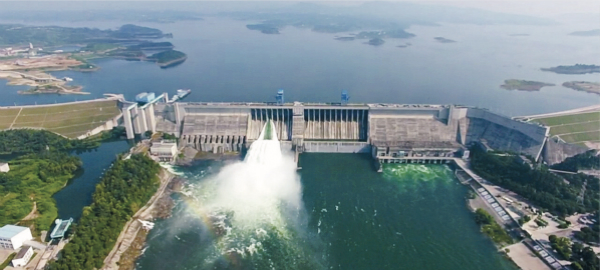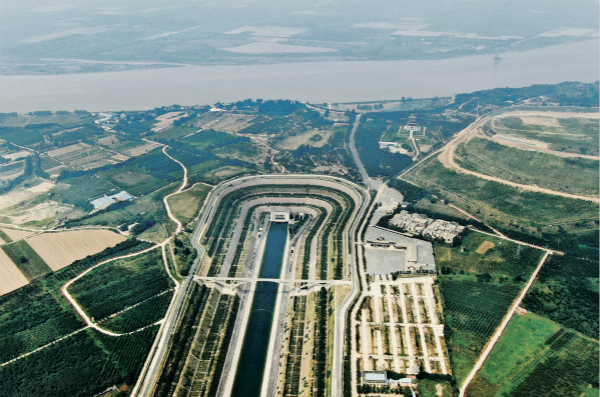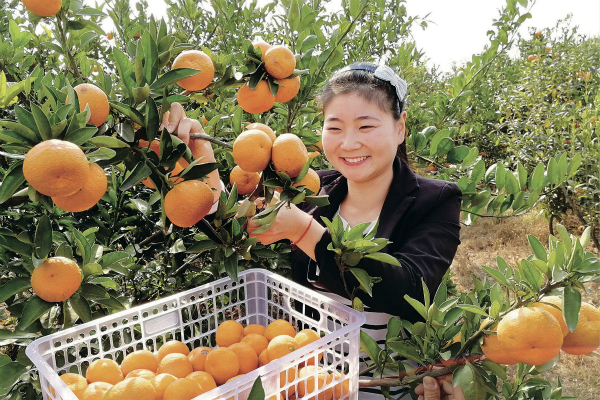Ecological Protection in the Water Source Area of the Middle Route of the South-to-North Water Diversion Project
The middle route of the South-to-North Water Diversion Project (SNWDP) opened in December 2014. In the 2,100 days since its operation, it has transported over 30 billion cubic meters of water, with a consistent quality rating of Grade II or above. Over 67 million people in 13 cities in Henan, 9 cities in Hebei, and 14 administrative districts in Tianjin rely on this "southern water" as their main source of potable water. In Beijing 73% of tap water comes from the same source. In this period, water hardness in the capital has dropped from 380 milligrams per liter to 130 milligrams per liter. In Hebei, five million people have bid farewell to their days of drinking high-fluorine and brackish water.
As a Chinese proverb states, "When you drink water, think of the source." Indeed, under the CPC leadership, one of the most admirable elements of the drive to deliver water northward has been the persistence of ecological protection in water source area.
The water source area of the middle route of the SNWDP covers the Danjiangkou Reservoir area and its upper reaches, encompassing 95,000 square kilometers of land in 49 counties and districts in the provincial-level jurisdictions of Henan, Hubei, Shaanxi, Sichuan, Gansu, and Chongqing. Thanks to 15 years of hard work since the project began in 2005, the water source area is now a picture of natural beauty, with lush mountains, rich forests, limpid waters, and a thriving wildlife population.
I
Cleaner water
When the project first kicked off, just 20 of the 42 sections evaluated in the Danjiangkou Reservoir area and its upper reaches met the required water quality standards. Some sections even fell below the inferior Grade V standard. However, consistent improvements on all sections since operations began have seen the required standards being reached. In the latest phase of testing, the Grade II standard was satisfied on all 109 indicators, and the Grade I standard was attained for 95% of routine indicators, while all special indicators satisfied the water quality standards for water source area. Water fetched from a depth of 15 meters from the reservoir can be enjoyed immediately.
A greener landscape
Previously, the areas around the reservoir were desert-like. As an old rhyme puts it, "On the bald mountains and jagged terrain, all is desert and mud flows freely in the rain." Rainwater washed mud and sediment into the reservoir, clouding its water. Now in Nanyang and Shiyan where the reservoir area is located, forest coverage has reached 40.5% and 66.7%, respectively. The "bald mountains" and "jagged terrain" of the past are nowhere to be found. Hundreds of miles of lush greenery now cloak the mountains.
Greater biodiversity
The protection and recovery of biodiversity has been an upshot of environmental improvements. The reservoir area is home to more than 800 different kinds of terrestrial vertebrates with economic or research value, 53 of which are key nationally protected species. Over 170 species of bird inhabit the area each year, and a host of precious plant resources grow here, too. The Scaly-sided merganser, a bird species listed as endangered on the International Union for Conservation of Nature's Red List of Threatened Species, has wintered in Huanglongtan National Wetland Park in Shiyan for six years in a row. The peach blossom jellyfish, nicknamed the "panda in the water," is also frequently observed in the area. Ferry Beach, located in Madeng Town, Xichuan County in Nanyang, has recently become known as "Egret Beach," taking its new name from the tens of thousands of egrets that come here every year.
More environmentally friendly industry
Not so long ago, the industrial structure of the water source area was unsophisticated and extensive in nature. Fertilizer and pesticides were overused in agriculture, mining and sand extraction were dominant industries, and the tertiary sector was devouring the area's natural resources. Now the mix of agricultural products has been adjusted, and farmers have switched to organic fertilizers and environmentally friendly pesticides. An environmentally friendly system of industry has gradually taken shape—primitive, oversized, dirty, and extensive polluters and high-energy consumers have been shut down, relocated, or undergone transformations. And a cleaner and more beautiful natural environment has been a boon for eco-tourism. It has attracted a steady stream of visitors to the area and lengthened service industry chains. These results prove the point that not only will a good environment produce good crops, but a good landscape will nurture good industries.
Better quality living
Stronger protection for the environment has helped, rather than harmed, the livelihoods of people in water sources areas, bringing continuous improvements to their lives. In local towns, greenery and waterways complement neat rows of modern buildings, while green hills and streams surround wide and well-kept village streets and alleys. Well-built and aesthetically pleasing houses, furnished with appliances like refrigerators and color televisions, clean water, and hygienic cooking and bathroom facilities are a clear source of satisfaction and joy for villagers. The betterment of their lives has instilled people with a greater appreciation for the mountains and rivers of their hometowns and filled them with enthusiasm about creating a better future for themselves. Many officials and ordinary people remarked that the transformational changes to their lives would have been impossible without the South-to-North Water Diversion Project.
II
Environmental protection in water source area is guided by Xi Jinping thought on environmental conservation. It proceeds from the notions of defending the natural environment, managing development, and protecting water sources, striking a balance between conservation and development, and between the protection of rivers and the achievement of moderate prosperity, and charts a distinctive path of green development that gives priority to the natural environment.

The Danjiangkou Reservoir, which feeds the middle route of the South-to-North Water Diversion Project. The middle route of the project was put into operation in December 2014, and has been running smoothly for more than 2,200 days. It has transferred in excess of 30 billion cubic meters of water, with water quality kept steady at grade II or above, and has directly benefitted more than 67 million people. PEOPLE'S DAILY / PHOTO BY CHEN HUAPING
First, improving the overall approach
In environmental protection, the first task water source area needed to undertake was to improve their approach and change their outlook. Embracing the idea that lucid waters and lush mountains are invaluable assets, Party members and officials were taken to visit models of ecological conservation and instilled with the principles of eco-economic theory. They were encouraged to count costs in a holistic way over long-term horizons. A climate of working together to "build an eco-civilization for all" was steadily created. The guidance and policy incentives helped to deepen the understanding of the SNWDP's importance among officials and the general public. Community level officials have remarked how they previously regarded environmental protection as a curse and the issues of water quality and people's livelihoods as Gordian knots. Now they have changed their thinking, a new world has opened up.
Second, applying region-wide planning
From beginning to end, ecological protection of water source area has been organized and directed at the national level. The National Development and Reform Commission has led the way in establishing a joint meeting involving 11 relevant central departments and the provinces of Henan, Hubei, and Shaanxi, thus applying top-level design and systematic planning to the coordination of up and downstream areas, left and right banks, and main tributaries. This has allowed for the development of clear ecological protection objectives, tasks, and major projects for the water source area, and for the integration of water source area protection into the overall framework for regional economic and social development. The three provinces have introduced relevant regulations, and the cities and counties concerned have followed up with implementation plans and targeted measures and requirements. Plans for the entire basin, region, and all sectors have given shape to a systematic blueprint for the implementation of ecological protection in the water source area.

The southern mouth of the tunnel crossing the Yellow River on the South-to-North Water Diversion Project, September 15, 2020 (drone photo). The mouth on the south side of the river is located in Xingyang, Zhengzhou, Henan Province, while the mouth on the north side is located in Wenxian County, Jiaozuo, Henan. The tunnel is a key part of the middle route of the water diversion project, and is responsible for moving water from the south to the north side of the Yellow River safely and effectively. PHOTO BY XINHUA REPORTER HAO YUAN
Third, resettling residents
Resettlement has played a key part in the ecological protection of the water source area. In Henan and Hubei, respectively, 166,000 and 182,000 people needed to be relocated. In this migration effort, the two provinces pursued a people-centered approach. They put much thought into moving and resettling residents and spent a considerable amount of energy on facilitating development and ensuring prosperity. After the move, local Party committees and governments introduced assistance and preferential policies, formulated plans on steadily creating prosperity, and plugged follow-up support programs for relocated residents into initiatives for rural revitalization and building a beautiful countryside. Thanks to detailed work plans, relocation work and prosperity development were properly aligned, the project tangibly benefited the people involved, and the original four-year work plan was basically completed in two years, with all residual tasks accomplished by the third year. Relocated residents have quickly settled into life in their new environment. The average living space per resident has almost doubled, as has per capita disposable income. People are genuinely appreciative of the Party's relocation policies and hold strongly positive attitudes about ecological protection for reservoirs.
Fourth, controlling pollution with a firm hand
The protection of water quality is largely tied to the prevention and control of pollution. In recent years, to keep sewage out of the reservoir, the relevant state departments and the water source area have joined forces to wage a battle against pollution, using firm measures and strict responsibilities. Pollution control has been carried out with "four resolute measures" (resolute shutdowns, bans, management, and construction). In terms of shutdowns, a major push has been made to eliminate backward production capacity and comprehensively control point source pollution. More than 2,551 companies as major polluters have been shut down, and 524 projects have been cancelled or denied approval. Resolute bans have been placed on mining, fishing, and breeding in accordance with the law; net pen culture practices have been addressed with strong measures; and a strict ten-year-long ban on fishing in the Yangtze River basin is now in force. A region-wide initiative has been launched to achieve zero-growth in the use of fertilizers and pesticides. Approval and management procedures are stringent, and the goal of removing all water-polluting enterprises from the water source area has been completed. In terms of management, comprehensive efforts are being made to address soil erosion, reinforce river banks, and carry out dredging, drainage, and other projects. Strong moves are being made to promote rural and urban sewage and garbage treatment and to deal with pollution originating from the livestock and poultry industries. In terms of construction, major efforts have been made to reinforce ecological and environmental infrastructure. Garbage and sewage treatment facilities have been installed in all counties in the water source area and key townships around the reservoir. Sewage treatment capacity has increased 6-fold and the daily garbage treatment capacity is 19 times higher. Sewage treatment plants above the county-level have all achieved A-level discharge standards, and the reservoir area and the main river source have maintained a 100% compliance rate year-round in cross-section monitoring.
Fifth, building firm ecological shields
Water quality in a river is fundamentally determined on land. In line with this systematic perspective, the focus of efforts to build strong ecological shields has been on tree planting and soil conservation. Since the middle route came into operation, soil erosion has been addressed on 1,981 square kilometers of land, and 0.17 million hectares of public-benefit forests have been planted, as well as nearly 50,000 hectares of key protective forests. At the national level, key projects are being carried out, including soil and water conservation initiatives in the Danjiangkou Reservoir area and its upper reaches, comprehensive management of soil and water erosion on hillside land, the return of farmland to forest and grasslands, and the protection of natural forests. At the local level, strict ecological red lines have been put in place to safeguard green land. Several major ecological restoration and protection projects are being carried out, greening programs are ongoing, and the restoration of ecosystems is proceeding in a systematic way. The construction of a series of ecological shields has provided permanent, robust support for the Danjiangkou Reservoir.
Sixth, upgrading industry
When ecological protection in the water source area began, all localities made a conscious effort to shift away from extensive and exploitative practices rooted in the land toward a new path featuring a deep level of integration between industrial development and ecological protection that would yield both ecological and economic gains. In agriculture, efficient, environmentally friendly, organic standards were adopted. In industry, supply-side structural reform has remained the main task. Traditional industries have been overhauled, new industry forms cultivated, and firm strides are being taken toward green development. In the service industry, the natural scenery of Qinba region, and the scenery, history, and culture of the Hanjiang and Danjiang rivers have been the focus points. Integrated tourism has been developed, and a string of tourism products have come on line.
Seventh, carrying out paired collaboration
As well as being a water supply line and lifeline for the arid North, the middle route project is also a connection for fostering friendship between North and South of the country. In line with a project approved by the State Council, Beijing is engaged in paired collaboration with relevant cities and counties in Henan and Hubei, and Tianjin is paired with relevant cities and counties in Shaanxi. Since 2013, 5.5 billion yuan worth of funding for collaboration have been invested, and more than 1,300 projects with a total investment of more than 40 billion yuan have been implemented; the localities involved have assigned more than 400 officials to their partner jurisdictions for short-term services, while tens of thousands of professionals have received training. Through collaboration, the relevant cities and counties in the water source area have broadened their horizons, attracted projects, and trained personnel. These efforts have strongly promoted ecological protection and high-quality development in the water source area.

A tourist picking tangerines in the town of Cangfang, Xichuan County, Nanyang, Henan Province, November 1, 2018. As an important source of water for the middle route of the South-to-North Water Diversion Project, Nanyang bears an important mission in providing clean water for people up north. In recent years, the place has leveraged its ecological strengths by focusing energy on the development of organic farming and embarking on a path of coordinated green development under the slogan "clean water, prosperous people." XINHUA
Eight, establishing long-term mechanisms
Ecological protection is not a one-off undertaking, but requires sustained efforts. The water source area has focused on building long-term mechanisms to enforce responsibility for water protection, strengthen overall linkages, improve monitoring mechanisms, and reinforce risk prevention and control. Water quality in the main rivers of the water source area is monitored automatically in real time; once irregularities are discovered, they are dealt with immediately. Environmental emergency response plans have been developed, and emergency response drills are conducted regularly. After a potentially dangerous situation occurred in January 2018, in which an unknown chemical polluted a river in Xixia County, Henan Province, the local authorities immediately sprang into action, while the national environmental protection authorities also mounted a swift response, thus ensuring the risk was effectively contained at the earliest time possible.
(Originally appeared in Qiushi Journal, Chinese edition, No. 22, 2020. Shortened from the original Chinese version.)
























